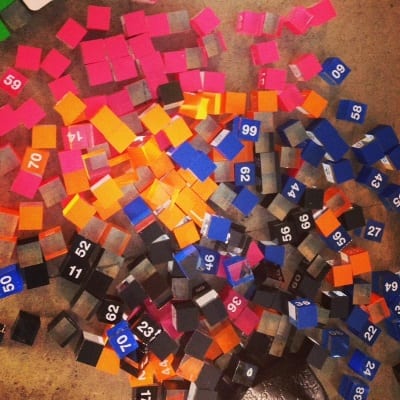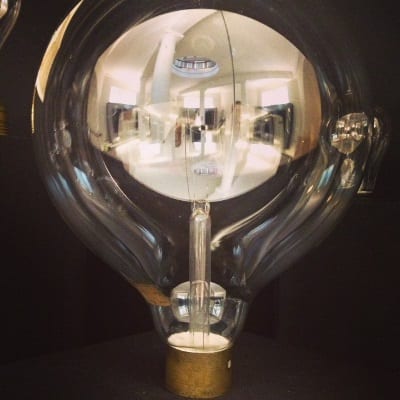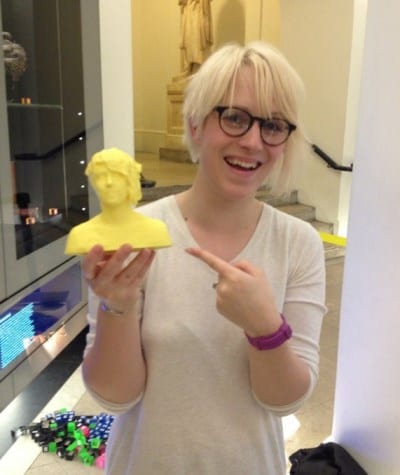Curating the Octagon Exhibition
By Claire S Ross, on 14 June 2013
Most of the last couple of weeks I have been busy installing the new Octagon Gallery Exhibition, ‘Digital Frontiers: Smart, Connected and Participatory’. It’s been a brilliant experience and I have learnt a lot so I thought I’d talk a bit about the process of creating an exhibition from a first time curator!
The exhibition opened at the beginning of June 2013. But it all first started when I applied to exhibit in the new Octagon space. UCL Museums invited proposals on a theme (in this instance the theme was ‘frontiers’) from across the UCL community. The proposals were judged by a panel and my application on the theme of ‘Digital Frontiers’ was successful. The proposal focused on key research areas from UCL Centre for Digital Humanities (UCLDH) and the UCL Centre for Advanced Spatial Analysis (CASA). It felt quite strange deciding on a theme without being fully aware of all the potential objects, but it paved the way for an exciting challenge to see how I could fit as many of UCL’s 18 disparate collections into my exhibition theme.
The first full meeting happened in January when I got together with all the curators and collections managers from the different UCL Museums and Collections and I explained my broad themes and plans for the exhibition. We had an initial brain storm and I was bit overwhelmed with all the information on objects that could potentially fit the exhibition concept. I then had one to one meetings with all the individual curators to discuss exhibition ideas and view possible objects, before going away and coming up with a really long list of potential objects.
Then came the object research. I wasn’t fully prepared for the amount of work researching objects takes. I now know a vast amount about Light Bulbs, Fleming Valves and Slide Rules. In fact it is safe to say I have become a bit obsessed with Light Bulbs.
One of the main challenges was overcoming the object data records from different collections. It’s not as simple of going into a central UCL collections database and calling up all the information there is on a specific object. Each collection has different recording fields, and some are more populated than others. In some cases, there was no object information at all. Eventually I (with the help of some very helpful UCL curators) managed to whittle down the incredibly long list of objects down into four key themes which followed some kind of narrative structure.
The final selection of objects were then checked by the conservators. Whilst the objects were undergoing damage checks, I had the mighty task of writing all of the object labels and case introductions. It is incredibly hard to write clear, concise, factually correct and engaging labels. It took months of checks, rewrites, and tweaks to come up with the final written interpretation. One of the joys of the Octagon space is that all the labels are on Digital touch screens, so I could continue to tweak the labels way past installation. I owe a huge amount of thanks to Phil Holmes, who perhaps foolishly offered to help read through my labels when I was despairing at my lack of label writing ability.
On top of the UCL Museums objects the exhibition has a few new objects including a range of 3D prints of my own head. The process of scanning and then printing my own head is incredibly bizzare and a huge thank you goes out to Steven Gray from UCL Centre for Advanced Spatial Analysis, who spent hours making sure my 3D head did not fall off my 3D shoulders during the printing process. Additionally there are a range of Smart objects and data visualisations included in the exhibition which have been provided by UCL Centre for Advanced Spatial Analysis. It is great to see historic collections sitting next to current research and how they compliment each other.
Finally came the time for installation. It took a week to install all the objects into four cases. I felt a bit dictatorial telling the curators where I wanted the objects to go, and then changing my mind and making them move them to a different position. We spent hours moving one object (a nautical galvanometer) to different positions and cases, because I had decided that I wanted to include its box as well as the object itself. The low point of the installation process was sitting and counting a large amount of jelly beans for part of the display. I don’t know how many times I lost count. During this time I was also responsible for uploading the label text, 3D objects, videos, images and data visualisations onto the digital rails. This meant I had to learn how to use the bespoke content management system for the digital rail interface. Finally came the case cleaning. The cases are massive and have an awful lot of glass that needs to be polished.
I would like to take this opportunity to say a big thank you to UCL Museums for giving me the opportunity to create my own exhibition, and to Susie Chan, the Exhibitions Co-Ordinator, for her excellent exhibition management and mount making skills and to all the curators, particularly Nick Booth, as I used an awful lot of the Geology & Historical Sciences Collections. A massive thank you also goes to Andy Hudson Smith from CASA for his help and support from project proposal to last minute launch projections, including providing some absolutely stunning data visualisations. Additional thanks to Melissa Terras from UCLDH for all the encouragement! ‘Digital Frontiers: Smart, Connected and Participatory’ runs until the end of the year.
Claire Ross is a PhD student and research assistant at the UCL Centre for Digital Humanities.
One Response to “Curating the Octagon Exhibition”
- 1
 Close
Close





[…] the past 6 months I have been curating an exhibition in UCL Museums newest exhibition space, the Octagon. The exhibition is all about digital […]